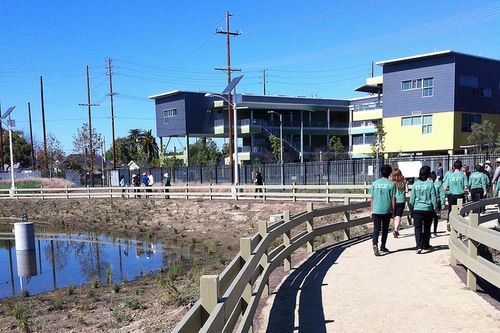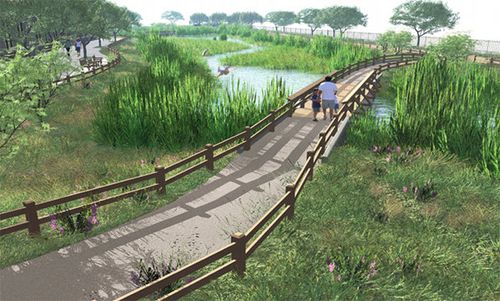
In South Los Angeles, a former bus and rail transit station has been replaced by a nine-acre park that includes native trees and plant gardens, walking trails and ponds that will filter storm water, using bacteria and plants to pull out pollutants before the water is fed into a storm drain.
The park, a former Metropolitan Transit Agency yard at Avalon Boulevard and 54th Street, was unveiled earlier this month and is the result of a three year, $26 million project. Some of the funding came through a bond measure that voters approved in 2006. Residents say the South Los Angeles Wetland Park offers a welcome change to the highly industrialized neighborhood, and an official with the Environmental Protection Agency calls the park a model for other cities that need new ways to safely treat polluted stormwater runoff.
Since the pools are in their infancy, they've not yet formed into fully functional wetlands, but another artificial wetland built in 2006, in Augustus F. Hawkins Natural Park just a mile away, is fully functioning, reports the the . Many species of birds, turtles and even an egret have taken up residence there, and are likely to also move into the newer park. This rendering shows what the park should look like once the wetlands are thriving:��

The new South Los Angeles Wetlands Park is park of a larger effort to clean up the Los Angeles River Watershed, which itself is part of a seven-city pilot program, the , which includes watershed restoration projects on the Bronx and Harlem rivers, Denver's��South Platte River and Lake Pontchartrain in New Orleans (Happy Mardi Gras!).
Artificial wetlands have long been used a means of both improving water quality in urban and agricultural areas and as a way to foster biodiversity and attract birds and other water-loving wildlife. In 1990, an artificial wetland was built in Phoenix, Arizona, in an effort to improve water quality without having to make major upgrades to an existing water treatment plant. The wetlands were so successful that they've been expanded to more than 800 acres and they process millions of gallons of effluent waste water each day.
— Mary Catherine O'Connor
��
Via the ��and